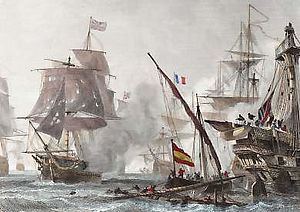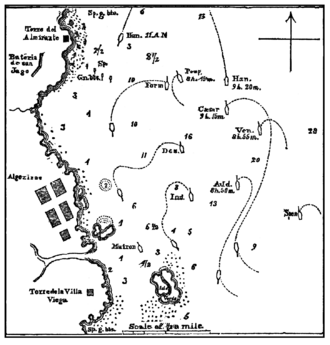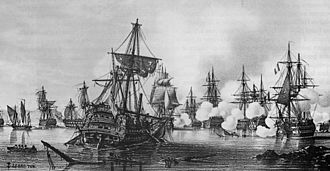First Battle of Algeciras facts for kids
Quick facts for kids First Battle of Algeciras |
|||||||
|---|---|---|---|---|---|---|---|
| Part of the French Revolutionary Wars | |||||||
 Algéciras, 6 Juillet 1801 by Alfred Morel-Fatio |
|||||||
|
|||||||
| Belligerents | |||||||
| Commanders and leaders | |||||||
| Strength | |||||||
| 6 ships of the line (OOB) | |||||||
| Casualties and losses | |||||||
| HMS Hannibal captured, 121 killed, 240 wounded and 14 missing |
5 gunboats sunk |
||||||
The First Battle of Algeciras was a naval battle fought on July 6, 1801. It took place between a group of British Royal Navy warships and a smaller French Navy group. The French ships were anchored in the Spanish port of Algeciras, which was well-protected by forts.
Even though the British had more ships, the French position was strong. It was guarded by Spanish cannons on land and tricky shallow areas (called shoals) that made it hard for ships to get close. The French group, led by Admiral Charles Linois, was on its way to a big Spanish naval base in Cadiz. There, they planned to join with Spanish ships to form a powerful fleet. This combined fleet would then fight against Britain and its allies in the French Revolutionary Wars.
The British, led by Rear-Admiral Sir James Saumarez, wanted to stop the French ships before they could reach Cadiz. If the French and Spanish fleets joined, they would be too strong for Saumarez. They could then attack British forces in the Mediterranean Sea.
Saumarez sailed directly from his station blocking Cadiz. His group had six ships of the line, which was twice as many as Linois had. On the morning of July 6, Saumarez found the French ships anchored in Algeciras. He immediately attacked the port, even though the bay had difficult shallow areas.
The first attack badly damaged the French ships. But light winds and shallow water caused a British ship, HMS Hannibal, to get stuck. It was then hit by heavy fire. The French ships were pushed ashore to stop them from being captured. Saumarez realized his plan wasn't working. He ordered his ships to leave. Five of his ships slowly left the bay, but the damaged Hannibal remained trapped. Captain Solomon Ferris on Hannibal was isolated and couldn't move. He kept fighting for another half hour before giving up his ship.
Both sides suffered a lot of damage and lost many sailors. But everyone knew the battle would happen again soon. So, after the British defeat, there was a lot of busy activity in Gibraltar, Algeciras, and Cadiz. While the British and French fixed their ships, the French and Spanish fleet in Cadiz got ready for a rescue mission. A strong group of ships arrived in Algeciras on July 12. As the Spanish ships left with Linois's ships, Saumarez's group attacked them again. This was the Second Battle of Algeciras. It happened at night, and the British ships were faster and could move better. The British caused heavy losses to the Spanish ships at the back. However, they still failed to destroy the French group.
Template:TOC limit=3
Contents
Why the Battle Happened
In 1798, the French Mediterranean Fleet was almost completely destroyed at the Battle of the Nile in Egypt. After this, the British Royal Navy became very powerful in the Mediterranean Sea. They started to block French and Spanish ports, like Toulon and Cadiz.
By 1801, the British were planning to invade and take back Egypt from the French. First Consul Napoleon Bonaparte wanted to rebuild the French fleet in the Mediterranean. He also wanted to send more soldiers to Egypt before the British invasion. So, a group of French ships was sent to Egypt. Also, an agreement was made with the Spanish Navy to give the French Navy six ships from their reserve in Cadiz.
In June 1801, a group of three French ships left Toulon for Cadiz. They were led by Admiral Charles Linois. Linois's orders were to join the French and Spanish fleet in Cadiz. He was also supposed to take control of the promised Spanish ships. From there, the combined fleet, with 1,500 French soldiers, could launch big attacks against British forces.
Linois left Toulon without any problems because the British ships blocking the port were not there. He sailed along the Spanish coast without being stopped. On July 3, he passed the British port of Gibraltar. There, Linois learned from Captain Lord Cochrane (who had been captured) that a strong British group of seven ships was off Cadiz.
Hearing this, Linois changed his plan. Instead of going straight to Cadiz, he anchored at Algeciras. This was a well-fortified town in Algeciras Bay, close to Gibraltar.
At Gibraltar, the only British ship in the harbor was the small sloop-of-war HMS Calpe. Its captain, George Dundas, saw the French ships and immediately sent a message to Saumarez off Cadiz. The message reached Saumarez on July 5. The admiral, who had fought in the Battle of the Nile, quickly gathered his ships and sailed east to investigate.
Saumarez only had six ships. One of his ships, HMS Superb, was on a separate mission. Saumarez sent messages to recall it. But the captain of Superb heard a wrong report that Linois had already left Algeciras. So, he decided to go back to his station watching the Spanish in Cadiz.
As Saumarez sailed towards Algeciras, the defenses there were made even stronger. Linois arranged his ships in a line across the harbor. His main ship, Formidable, was at the north end. Then came Desaix and Indomptable to the south. Each ship was about 500 yards apart. The frigate Muiron was placed in shallower water.
The French position was also helped by 11 large Spanish gunboats. These were at the northern end of the harbor. Forts and batteries on land also overlooked the area. The southern approach was covered by more gunboats and forts. The fortified island of Isla Verda, with seven heavy cannons, was between Indomptable and Muiron. The bay's tricky shallow areas and rocks also made it hard for unfamiliar sailors to navigate.
The Battle Begins

Saumarez's ships were delayed by winds and didn't reach Algeciras until 7:00 AM on July 6. The British admiral decided to attack the French ships right away. Thousands of people watched from the Spanish and Gibraltar shorelines.
HMS Venerable was supposed to lead the attack because its captain, Samuel Hood, knew the waters best. But once in the bay, the wind died down, and Hood's ship became stuck. So, the first shots came from a battery on Cabrita Point, hitting HMS Pompee.
As the British ships got closer, Linois ordered his French ships to move into shallower water near the shore. Many French sailors and soldiers went to help the Spanish cannons on land. The French ships also began firing as Pompee and HMS Audacious came within range.
Saumarez and the rest of the British ships were about 3 miles behind. But Captain Charles Stirling on Pompee pushed ahead. He sailed close to Isla Verda and fired at each French ship. At 8:45 AM, he anchored next to Formidable and fired from close range. Venerable and Audacious struggled with light winds further out. They didn't join the fight until 8:50 AM. They fired at Desaix and Formidable, but from too far away.
The French and Spanish fired back heavily at the anchored British ships. After half an hour, Formidable stopped firing and slowly moved further inshore. Suddenly, Pompee was caught by a new current. This turned the ship so its front faced Formidables side, allowing the French to fire along its length. Only a few of Pompees front cannons could fire back. Captain Dundas in Calpe helped by engaging the Spanish batteries and the frigate Muiron. Muiron was short on crew but still strong enough to drive off the smaller Calpe.
At 9:15 AM, the rest of the British ships arrived. The flagship HMS Caesar anchored and fired on Desaix. At 9:20 AM, HMS Hannibal joined the fight. This left only HMS Spencer unengaged. It was stuck without wind and came under heavy fire from shore batteries, some firing hot cannonballs to start fires.
Saumarez ordered Captain Ferris on Hannibal to move his ship closer to Formidable to attack it better. Ferris slowly sailed north, then turned back towards Formidable. This worked at first. But at 11:00 AM, Hannibal ran aground (got stuck) near the Torre de Almirante. From this spot, Ferris could fire at Formidable and the Spanish defenses. But his ship was very exposed to enemy fire.
Hannibal was now alone at the northern end of the British line. It was under heavy fire from Formidable, Spanish batteries, and gunboats. It couldn't move or fight back well. Ferris tried to tell Saumarez his ship was in trouble, but his signal ropes were shot away. Other British ships tried to tow Hannibal off the shoal, but they failed. Hannibal was left stranded as the wind died down, preventing other British ships from helping.
However, a light wind from the northwest helped the French. Linois ordered his ships to cut their anchor cables and move into stronger positions closer to shore. Formidable succeeded. But Indomptable and Desaix couldn't be controlled in time and also ran aground.
Saumarez responded by cutting his own cables on Caesar. He sailed past the stuck Audacious and Venerable. He then took a position near Indomptable's front, firing repeatedly at the stranded ship. Audacious followed, also firing on Indomptable. But both Caesar and Audacious were now directly exposed to heavy fire from Isla Verda. The batteries there were now manned by French sailors who had left their grounded ships.
British Ships Retreat
To the north, the trapped Pompée and Hannibal were under heavy fire from Formidable and many Spanish batteries and gunboats. Both ships were badly damaged and couldn't fire back well. On Hannibal, the situation was hopeless. More than sixty men had been killed. Its main and rear masts were shot away, and the ship was still stuck.
Pompée was slightly better off. Its ropes and sails were torn, but its masts were still standing, and it was floating. At one point, Pompée's flag was shot away, making the French think it had surrendered. But the flag was quickly put back up. At 11:30 AM, Saumarez ordered the rest of his ships to send boats to tow Pompée out of danger. These boats came under heavy fire, and some were sunk.
Because the boats were helping Pompée, Saumarez couldn't launch a planned attack on Isla Verda with his Royal Marines. Also, in the light wind, Caesar and Audacious were drifting dangerously close to the shallow areas around the island. If they got stuck, they would face the same fate as Hannibal.
Seeing his attack fail, Saumarez signaled at 1:35 PM for his ships to retreat to Gibraltar. Pompée was already on its way thanks to the towing boats. Caesar and Audacious cut their anchors and slowly left the bay. A sudden land breeze helped them quickly get out of range of the French and Spanish guns. Venerable and Spencer joined them as they left. The damaged British ships returned to Gibraltar, leaving the almost mastless Hannibal stuck in Algeciras harbor.
On Hannibal, over sixty men had been killed. Captain Ferris ordered the survivors below deck to escape the heavy fire. The combined French and Spanish guns focused on Hannibal, starting several fires. By 2:00 PM, Ferris saw that fighting was useless. He ordered the ship's flag to be taken down, which meant surrendering. French and Spanish soldiers then boarded the ship. Hannibal's surgeon later said that many wounded men were trampled as the boarding parties tried to put out the fires.
Later, Hannibal's flag was put back up upside down, which is an international signal of distress. Captain Dundas, watching from Gibraltar, thought this meant Ferris was still fighting and needed help. Boats were sent from Gibraltar with carpenters to fix Hannibal. Dundas took HMS Calpe back into the bay to help. But he came under heavy fire and left when he realized his mistake. However, several of the boats were captured by the French.
After the Battle
Both sides had many casualties and damage. The British lost 121 killed, 240 wounded, and 14 missing. The missing were thought to have drowned. Besides losing Hannibal, Pompée and Caesar were also badly damaged. Venerable and Spencer had less damage.
The French had more casualties, with 161 killed and 324 wounded. All three French ships were damaged. Saumarez thought they were "unserviceable" (couldn't be used), but he was wrong. Indomptable and Desaix were especially damaged. The frigate Muiron, which stayed in shallow water, was fine. The Spanish reported 11 men killed. Five of their gunboats were sunk. The British found that their cannon fire often went over the French ships and hit the town of Algeciras, causing much damage. The Spanish later accused Saumarez of purposely targeting the town.
On July 7, Saumarez sent Captain Brenton to Algeciras to discuss returning Captain Ferris and his officers. This was agreed upon, and Ferris, his officers, his wounded men, and the officers from HMS Speedy were sent to Gibraltar. By August 1801, Ferris and his officers were back in Britain. A court-martial (a military trial), which was standard when a ship was lost to the enemy, was held. The court found that Ferris had acted bravely and cleared him of any blame.
Right after the battle, both Algeciras and Gibraltar worked hard to repair their damaged warships. Everyone expected the fighting to continue. In Gibraltar, Saumarez decided to temporarily leave Pompée and Caesar and use their crews to get the other ships ready. But Captain Brenton of Caesar disagreed. By working non-stop for three days, Caesar's crew got their ship ready for Saumarez to sail again.
This speed was needed because Linois, while fixing his own ships and getting the captured Hannibal ready, had sent a message to Cadiz. He asked for more ships before Saumarez could attack again. So, a strong Spanish force arrived off Algeciras Bay on July 9. This force was watched by Superb, which then joined Saumarez at Gibraltar.
At Algeciras, the Spanish ships planned to pick up Linois and escort his damaged ships to Cadiz. They had five ships, including two huge 112-gun ships. Hannibal was too damaged to travel and stayed in Algeciras harbor. But the rest of the French and Spanish ships sailed for Cadiz on July 12. That night, Saumarez's repaired ships attacked them in the Second Battle of Algeciras. The Spanish ships at the back were overwhelmed. The two 112-gun ships both sank, with over 1,700 lives lost. Another ship was captured. But Linois's force managed to reach Cadiz the next morning. Hannibal was later taken by the French and renamed Annibal.
In France, the victory was celebrated. Linois was called a national hero and given a special sword by Napoleon. The French victory over a stronger British force was unusual. Saumarez publicly said the battle was a victory, but privately, he knew it was a defeat. Historians say that the French fought well, and a mix of weather, luck, and shore support gave them the win against a stronger force.
See also
 In Spanish: Primera batalla de Algeciras para niños
In Spanish: Primera batalla de Algeciras para niños
Images for kids
-
The battle of Algeciras, Alfred Morel-Fatio





